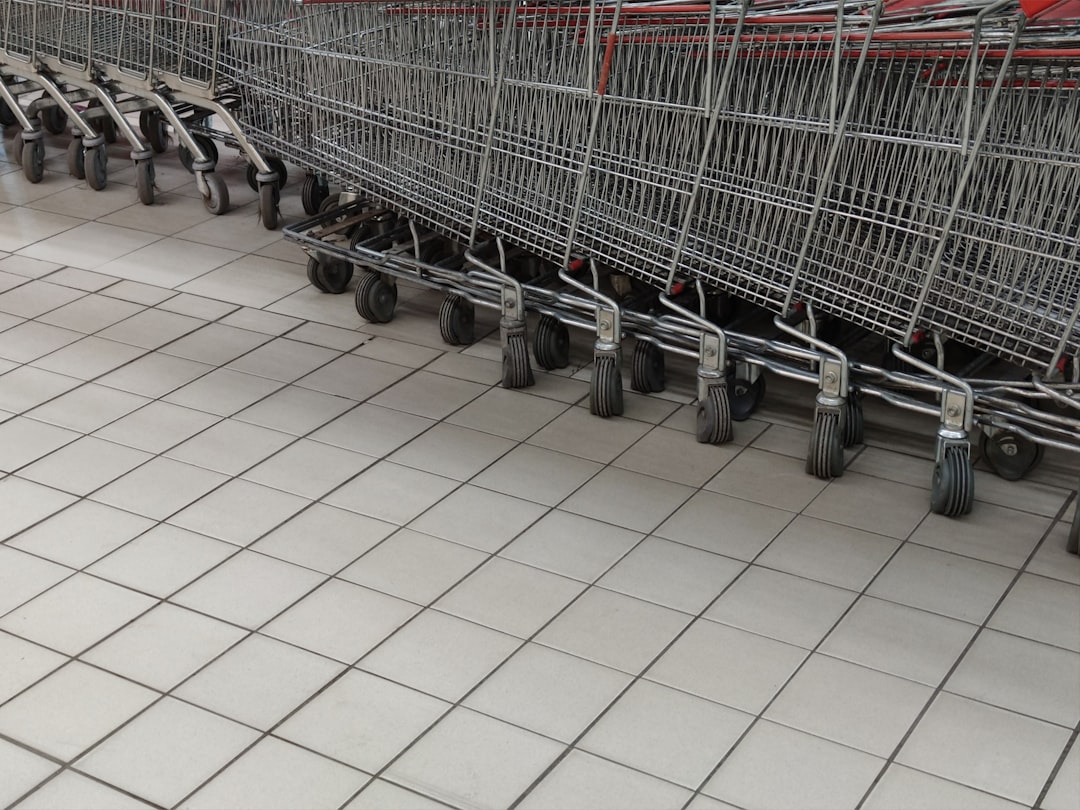

Engage prospects with a scan and streamline customer engagement with FREE QR code marketing tools by Sona – no strings attached!
Create a Free QR CodeFree consultation

No commitment

Engage prospects with a scan and streamline customer engagement with FREE QR code marketing tools by Sona – no strings attached!
Create a Free QR CodeFree consultation

No commitment
QR codes have transformed from a novelty to a strategic asset in connecting offline engagement with online action. For shopping cart suppliers, retail QR codes provide a seamless way to link in-store shoppers with digital content, promotions, customer support, and streamlined checkouts, all without the need for an app or complicated registration.
In a competitive market, shopping cart suppliers must focus on customer experience and operational efficiency. Missed opportunities to capture valuable shopper data at decision points can result in lost insights and limit personalization. Many buyers now seek technology-enabled carts that support mobile payments, access to product information, and effective intent-driven retargeting, allowing retailers to capture more actionable data and reduce cart abandonment.
By utilizing QR codes, shopping cart suppliers and their retail partners can direct shoppers from the point of decision straight to targeted offers and product details, including Google Forms QR. This leads to faster conversions, richer engagement, and actionable data to improve future campaigns. By building feedback loops from the cart to digital platforms, suppliers can overcome barriers in capturing and understanding valuable prospects.

QR codes bridge the gap between physical shopping carts and digital destinations, enabling suppliers to provide retailers with direct paths to conversions such as loyalty sign-ups, coupon activations, and digital self-checkout. Many environments struggle when prospects explore offers but fail to complete forms or sign-ups, leading to valuable leads being lost. Placing strategic QR codes on cart handles, child seats, or digital screens makes engagement immediate and trackable, while giving shoppers the clarity and speed they expect.
Start by defining your goals and mapping QR interactions to the most relevant conversion events. If the objective is loyalty enrollment, a QR code on the cart handle that opens a two-step mobile form will outperform clipboards and paper applications. If the goal is faster checkout, a cart-mounted code can open a scan-and-go flow and connect to mobile wallets. Each scan becomes an intent-rich data point that signals where the shopper is in the journey and what to deliver next.
Analog processes that once held back performance can be modernized with QR-enabled flows. Printed brochures can route to dynamic landing pages that update weekly offers. Manual sign-up sheets can become mobile-optimized forms that pre-fill fields and enforce validation. Help desk phone numbers can transform into instant message threads or self-service knowledge bases, reducing wait times and pressure on store staff. With a platform like Sona QR, suppliers can centralize code management, refresh destinations without reprinting, and feed real-time data into CRMs and analytics.
Success depends on a few fundamentals. Prominent placement and a clear call to action drive initial engagement. Clean, mobile-first landing pages reduce friction and encourage completion. Analytics that connect scans to downstream outcomes reveal what to keep, what to change, and where to invest. In short, QR codes give shopping cart suppliers a proven path to higher conversions while improving shopper experience and operational efficiency.

Shopping cart suppliers must deliver seamless, omnichannel engagement as retailers and customers expect more convenience. Persistent challenges such as missed opportunities to identify decision-makers or capture anonymous traffic can limit growth. QR codes solve several bridging challenges between physical cart interactions and digital activities, turning moments of attention into measurable action.
In retail environments, printed signage, cart branding, and in-aisle promotions often lack attribution. Shoppers see offers but leave without converting, and suppliers cannot easily tell what worked. QR codes add a direct response mechanism to every cart and collateral piece, which shortens the path to action, boosts participation in loyalty and coupons, and brings offline behavior into digital analytics. For cart manufacturers and solution providers, this creates a differentiated offering: a cart that is not just a utility, but also a data-rich, conversion-driving channel. For broader inspiration on engagement tactics, explore these QR marketing strategies.
For shopping cart suppliers, QR codes elevate each cart into a measurable, intelligent asset. The result is reduced data gaps, better personalization, and a clearer line of sight from in-store interaction to online conversion.
Different goals call for different QR formats. Shopping cart suppliers and their retail partners can mix and match formats based on the action they want to encourage and the data they need to collect. Choosing the right format ensures your QR deployments work in harmony with store operations and marketing systems.
Prioritize formats that streamline core retail tasks and shopper needs. For example, forms fit feedback and service workflows; Wi-Fi access removes connection friction for mobile checkout; web links and app downloads support product discovery and engagement. When in doubt, use dynamic QR codes so you can adjust the destination without reprinting assets.
Dynamic QR codes managed through a platform like Sona QR give suppliers campaign flexibility and control. You can A/B test destinations, update content by region, pause underperforming links, and preserve attribution even as campaigns evolve.

Growth often hides in moments where attention is high but action is hard to track. Shopping cart suppliers and retailers can place QR codes in retail at intentional touchpoints to capture interest early, extend engagement throughout the trip, and follow up after checkout. Map QR placements to distinct stages of the shopper journey and align each with a clear promise.
Begin with visibility and convenience. Carts move everywhere a shopper goes, so codes on handles, baskets, and child seats are prime real estate. Extend QR coverage to in-aisle signage, cart corrals, service desks, and take-home materials. The goal is not to flood every surface with codes; it is to use a small number of high-quality, purpose-built codes that each deliver a clear benefit.
Understanding shopper routines and identifying failure points in data collection will uncover high-impact opportunities. For instance, if coupon activation is strong but loyalty enrollments lag, place a loyalty-focused QR at the exit and in the cart bay with a simple incentive such as 10 percent off the next purchase after a two-field sign-up.

QR codes work best when they are tied to specific, measurable outcomes. For shopping cart suppliers, three use cases consistently deliver results while enhancing the shopper experience. Each one converts anonymous attention into actionable engagement, and each can be customized by region, store, or audience segment.
The following use cases map neatly to common cart touchpoints and in-store moments. They deliver both convenience for shoppers and measurable lift for retailers and let suppliers show clear value beyond hardware quality and durability.
These use cases also compound over time. Loyalty growth increases the reach of targeted offers. Self-checkout adoption reduces operational bottlenecks and frees staff for higher-value tasks. Product education decreases returns and improves reviews. Together, they convert carts into always-on marketing and service assets.
Shopping cart suppliers and retailers often struggle to re-engage shoppers who show interest in promotions but do not convert during the visit. Every QR code scan can become a retargeting signal that helps you personalize follow-ups, extend the conversation after checkout, and recover would-be abandoners. The key is to deploy multiple codes across touchpoints and tag each one with a journey stage and use case.
Set up your data pipeline so each scan event routes to your CRM or CDP with context. Track the source code, placement, timestamp, and destination page. With Sona QR, you can sync these fields automatically into tools like HubSpot or Salesforce, then trigger segments and campaigns based on the intent behind the scan. For deeper setup guidance, see Sona + HubSpot. For shopping cart suppliers, useful audience distinctions include in-store first-time scanners vs. returning scanners, loyalty members vs. non-members, and self-checkout users vs. traditional checkout shoppers.
Context boosts accuracy. A scan on a weekday evening near checkout may signal intent to purchase immediately, while a scan on a home-delivered flyer may indicate research mode. Use timing and location to adjust messaging cadence and creative. Suppliers can then offer retailers pre-built retargeting recipes that transform scans into sales conversations and loyalty growth.
QR codes are more than convenient links. They are connective tissue across your offline and digital efforts, enabling real-time engagement and richer attribution. For shopping cart suppliers, this means every cart, flyer, and screen can become a measurable starting point for a cohesive customer journey.
Align QR code deployment with the retailer’s broader marketing calendar. For example, sync code destinations with weekly ad cycles, seasonal promotions, or vendor-funded displays. Add UTM parameters to every destination so that scans roll up cleanly into channel reports. A platform like Sona QR simplifies this by centralizing code creation, monitoring performance, and pushing data into CRM and ad platforms for coordinated follow-up.
With a centralized platform like Sona QR, suppliers can manage all codes across placements and channels, monitor performance in real time, and sync scan data to revenue systems. This multi-channel approach makes shopping carts a core component of a modern, measurable growth engine.
Executing a QR campaign in retail environments is straightforward when you break it into clear steps. The following checklist helps shopping cart suppliers plan, launch, and optimize initiatives that improve conversion, experience, and data capture.
Before you begin, align with your retail partners on goals, incentives, and messaging. A compelling offer and a short, mobile-first destination will drive higher scan and completion rates. Keep design consistent with store branding, and confirm that staff understand how to promote the scan action in natural moments, such as when a shopper picks up a cart or asks about deals.
Define a single, measurable goal for the campaign and select the cart placement that aligns with it. Common supplier-driven goals include increasing loyalty sign-ups, accelerating self-checkout adoption, or collecting maintenance feedback. For example, a loyalty drive is best placed on the cart handle with a benefit-forward CTA such as Scan to join and save now.
Choose between static and dynamic codes based on your need for flexibility and data. Static codes suit evergreen experiences like a safety guide PDF. Dynamic codes unlock tracking, editing, and audience building without reprinting.
Invest in clear, branded design and rigorous testing. A QR code is only as effective as its visibility, scannability, and the clarity of its call to action.
Roll out codes where they will have the greatest effect and align with shopper behavior. Coordinate timing with store promotions and ensure staff can answer common questions.
Measure from scan to revenue and refine in near real time. Optimization is not a one-time event; it is an ongoing practice that compounds gains across seasons and campaigns.
It can be hard for suppliers to measure value beyond scan rates. The real goal is to connect scans to tangible outcomes such as enrollments, redemptions, and purchases. A robust analytics approach closes the loop by showing which placements, offers, and audiences create pipeline and revenue, not just clicks.
Use a layered measurement model. First, capture scan metadata and destination performance. Next, integrate with CRM and point-of-sale data to attribute conversions. Finally, analyze performance by cohort: by store, by cart type, by time of day, and by creative variant. Sona QR paired with Sona.com streamlines this journey, from capturing real-world engagement to resolving anonymous scans to known buyers and attributing revenue across touchpoints.
This data-driven approach turns QR codes from a novelty into a performance channel. It also equips suppliers with the evidence retailers want to see: which cart features and QR experiences deliver higher conversions, stronger loyalty, and incremental revenue.
As QR usage grows, small refinements can make a big difference in scan volume and conversion quality. Treat every code as a mini product with its own hypothesis, message, and optimization plan. Focus on clarity, convenience, and measurable value, and keep the operational realities of a busy store front of mind.
Education is also essential. Shoppers may not always know what to expect from a scan, and staff may forget to promote it if the value is not obvious. Short scripts, simple incentives, and consistent visual cues help build scanning habits that persist across trips and stores.
Small creative touches can lift results. For example, a seasonal color frame around the code can signal freshness. A countdown to deal expiration on the landing page can increase urgency. And a progress bar on multi-step forms can reduce abandonment.

Learning from peers shortens the path to impact. While every retailer and region differ, patterns emerge across successful QR deployments in cart-centric environments. The common denominator is a clear value exchange, consistent promotion, and disciplined measurement that informs iteration.
Below are examples inspired by real outcomes in retail scenarios, paired with tactics you can adapt. Consider piloting one or two ideas, then expanding based on data.
Results like these are achievable because QR codes insert measurable micro-moments into a previously anonymous path. When suppliers bring both hardware and analytics to the table, they win longer contracts and deeper partnerships with retailers.
Even strong QR concepts can falter when execution details are overlooked. Consider the ergonomics of cart usage, the realities of glare and clutter, and the cognitive load of busy shoppers with children or multiple tasks. Aim for large codes, high contrast, and short, benefit-led CTAs. Couple this with landing pages that load fast, focus on one outcome, and work beautifully on any phone.
Conversely, several mistakes routinely erode results. Avoid hard-to-scan placements, confusing offers, and dead or outdated links. Do not forget to archive or redirect campaign codes when promotions end. And do not skip staff enablement, since casual in-person prompts often double scan rates.
QR codes are more than shortcuts; they are powerful tools for shopping cart suppliers who want to turn each cart into a conversion engine and source of actionable insights. By integrating QR codes throughout retail carts and marketing channels, suppliers deliver immediate shopper engagement, bridge offline and online activity, and unlock new opportunities to capture hidden signals and drive effectiveness.
This strategy empowers suppliers to offer retailers tangible solutions that enhance both cart functionality and marketing impact. Customer loyalty grows, follow-ups become more relevant, and segmentation is more effective, closing data gaps and reducing cart abandonment. In today's competitive environment, advanced QR strategies make every scan a step toward greater revenue, deeper insight, and sustained growth. If you are ready to put this into practice, generate and track your first codes with Sona QR, connect scan data to outcomes with book a demo, and Start creating QR codes for free to make your shopping carts the start of a measurable, modern retail journey.
QR codes have revolutionized the shopping cart suppliers industry by transforming traditional product displays into interactive, measurable conversion drivers. Whether it’s attracting new clients, enhancing the buyer’s journey with instant access to product info, or streamlining reorders, QR codes turn static carts into powerful sales tools that capture real-time customer engagement and boost revenue.
Imagine knowing exactly which shopping cart designs or promotions lead to increased orders—and having the flexibility to adjust campaigns instantly without costly reprints. With Sona QR, you can create dynamic, trackable QR codes in seconds, update your marketing on the fly, and link every scan directly to sales performance. No missed leads, no guesswork—just smarter strategies that accelerate growth.
Start for free with Sona QR today and transform every shopping cart into an opportunity to engage, convert, and grow your business.
QR codes link in-store shoppers with digital content, promotions, customer support, and streamlined checkouts without needing an app, providing instant access to offers and helpful information that enhances convenience and engagement.
Incorporating QR codes into shopping carts enables faster conversions, richer shopper engagement, actionable data collection, reduced cart abandonment, and transforms carts into data-rich, conversion-driving channels.
Choose suppliers who offer technology-enabled carts with QR code integration that supports mobile payments, access to product information, intent-driven retargeting, and centralized code management for real-time data and campaign flexibility.
Latest trends include using dynamic QR codes for flexible content updates, integrating QR codes across multi-channel marketing, deploying codes on cart handles and baskets for loyalty and checkout, and leveraging scan data for audience building and retargeting.
QR codes increase sales by shortening the path to action through instant access to loyalty sign-ups, coupons, and scan-and-go checkout, capturing intent-rich data to personalize follow-ups and reducing operational bottlenecks.
Use Sona QR's trackable codes to improve customer acquisition and engagement today.
Create Your FREE Trackable QR Code in SecondsJoin results-focused teams combining Sona Platform automation with advanced Google Ads strategies to scale lead generation

Connect your existing CRM

Free Account Enrichment

No setup fees
No commitment required

Free consultation

Get a custom Google Ads roadmap for your business






Launch campaigns that generate qualified leads in 30 days or less.
